Depth-Sensing Hardness Measurements to Probe Hardening Behaviour and Dynamic Strain Ageing Effects of Iron during Tensile Pre-Deformation
Abstract
1. Introduction
2. Materials and Methods
2.1. Material
2.2. Mechanical Deformation of Specimens
2.3. Microstructural Characterization
2.4. Nanoindentation Testing
3. Results and Discussion
3.1. Hardness and Young’s Modulus from Nanoindentation
3.2. Pile-Up Effect on the Mechanical Properties
3.3. Relation between Mechanical Properties from Tensile Tests and Hardness Measurements
3.4. Elastic Modulus Correction
3.5. Dynamic Strain Ageing (DSA) Effect on Strain Hardening
4. Conclusions
Author Contributions
Funding
Institutional Review Board Statement
Informed Consent Statement
Data Availability Statement
Acknowledgments
Conflicts of Interest
References
- Kositski, R.; Mordehai, D. Depinning-controlled plastic deformation during nanoindentation of BCC iron thin films and nanoparticles. Acta Mater. 2015, 90, 370–379. [Google Scholar] [CrossRef]
- De Guzman, M.S.; Neubauer, G.; Flinn, P.A.; Nix, W.D. The Role of Indentation Depth on the Measured Hardness of Materials. MRS Proc. 1993, 308, 613. [Google Scholar] [CrossRef]
- Mordehai, D.; Kazakevich, M.; Srolovitz, D.J.; Rabkin, E. Nanoindentation size effect in single-crystal nanoparticles and thin films: A comparative experimental and simulation study. Acta Mater. 2011, 59, 2309–2321. [Google Scholar] [CrossRef]
- Bahr, D.; Morris, D.J. Nanoindentation: Localized Probes of Mechanical Behavior of Materials. In Springer Handbook of Systematic Musicology; Sharpe, W., Ed.; Springer: Boston, MA, USA, 2008; pp. 389–408. [Google Scholar]
- Leitner, A.; Maier-Kiener, V.; Kiener, D. Dynamic nanoindentation testing: Is there an influence on a material’s hardness? Mater. Res. Lett. 2017, 5, 486–493. [Google Scholar] [CrossRef] [PubMed]
- Durst, K.; Göken, M.; Pharr, G.M. Indentation size effect in spherical and pyramidal indentations. J. Phys. D Appl. Phys. 2008, 41, 074005. [Google Scholar] [CrossRef]
- Ruiz-Moreno, A.; Hähner, P. Indentation size effects of ferritic/martensitic steels: A comparative experimental and modelling study. Mater. Des. 2018, 145, 168–180. [Google Scholar] [CrossRef]
- Moharrami, N.; Bull, S. A comparison of nanoindentation pile-up in bulk materials and thin films. Thin Solid Films 2014, 572, 189–199. [Google Scholar] [CrossRef]
- Liu, M.; Lu, C.; Tieu, K.A.; Zhou, K. Crystal plasticity FEM study of nanoindentation behaviors of Cu bicrystals and Cu–Al bicrystals. J. Mater. Res. 2015, 30, 2485–2499. [Google Scholar] [CrossRef]
- Liu, M.; Tieu, A.K.; Peng, C.-T.; Zhou, K. Explore the anisotropic indentation pile-up patterns of single-crystal coppers by crystal plasticity finite element modelling. Mater. Lett. 2015, 161, 227–230. [Google Scholar] [CrossRef]
- Tabor, T. The Hardness of Metals; Clarendon Press: Oxford, UK, 1948. [Google Scholar]
- Nix, W.D.; Gao, H. Indentation size effects in crystalline materials: A law for strain gradient plasticity. J. Mech. Phys. Solids 1998, 46, 411–425. [Google Scholar] [CrossRef]
- Armstrong, R.W. 60 Years of Hall-Petch: Past to Present Nano-Scale Connections. Mater. Trans. 2014, 55, 2–12. [Google Scholar] [CrossRef]
- Ren, S.; Mazière, M.; Forest, S.; Morgeneyer, T.F.; Rousselier, G. A constitutive model accounting for strain ageing effects on work-hardening. Application to a C-Mn steel. Comptes Rendus Mécanique 2017, 345, 908–921. [Google Scholar] [CrossRef]
- Caillard, D. Dynamic strain ageing in iron alloys: The shielding effect of carbon. Acta Mater. 2016, 112, 273–284. [Google Scholar] [CrossRef]
- Terentyev, D.; Xiao, X.; Dubinko, A.; Bakaeva, A.; Duan, H. Dislocation-mediated strain hardening in tungsten: Thermo-mechanical plasticity theory and experimental validation. J. Mech. Phys. Solids 2015, 85, 1–15. [Google Scholar] [CrossRef]
- Hirsch, P.; Howie, A.; Nicholson, R.; Pashley, D.W.; Whelan, M.J. Microscopy of Thin Crystals; Krieger Publishing Company: Malabar, FL, USA, 1977. [Google Scholar]
- Dubinko, A.; Terentyev, D.; Bakaeva, A.; Verbeken, K.; Wirtz, M.; Hernández-Mayoral, M. Evolution plastic deformation in heavily deformed and recrystallized tungsten of ITER specification studied by TEM. Int. J. Refract. Mater. 2017, 66, 105–150. [Google Scholar] [CrossRef]
- Herrmann, K.; Jennett, N.; Wegener, W.; Meneve, J.; Hasche, K.; Seemann, R. Progress in determination of the area function of indenters used for nanoindentation. Thin Solid Films 2000, 377, 394–400. [Google Scholar] [CrossRef]
- Oliver, W.C.; Pharr, G.M. Measurement of hardness and elastic modulus by instrumented indentation: Advances in understanding and refinements to methodology. J. Mater. Res. 2004, 19, 3. [Google Scholar] [CrossRef]
- Oliver, W.; Pharr, G. An improved technique for determining hardness and elastic modulus using load and displacement sensing indentation experiments. J. Mater. Res. 1992, 7, 1564–1583. [Google Scholar] [CrossRef]
- Bolshakov, A.; Pharr, G.M. Influences of pile-up on the measurement of mechanical properties by load and depth sensing indentation techniques. J. Mater. Res. 1998, 13, 1049. [Google Scholar] [CrossRef]
- Kese, K.; Li, Z.C. Semi-ellipse method for accounting for the pile-up contact area during nanoindentation with the Berkovich indenter. Scr. Mater. 2006, 55, 699–702. [Google Scholar] [CrossRef]
- Ruiz-Moreno, A.; Hähner, P.; Kurpaska, L.; Jagielski, J.; Spätig, P.; Trebala, M.; Hannula, S.-P.; Merino, S.; De Diego, G.; Namburi, H.; et al. Round Robin into Best Practices for the Determination of Indentation Size Effects. Nanomaterials 2020, 10, 130. [Google Scholar] [CrossRef] [PubMed]
- Caillard, D. A TEM in situ study of alloying effects in iron. II—Solid solution hardening caused by high concentrations of Si and Cr. Acta Mater. 2013, 61, 2808–2827. [Google Scholar] [CrossRef]
- Key, A.S.; Nakada, Y.; Leslie, W.C. Dynamic strain ageing in iron and steel. In Dislocation Dynamics; Rosenfield, A.R., Hahn, G.T., Bement, A.L., Jr., Jaffee, R.I., Eds.; McGraw-Hill Book Company: New York, NY, USA, 1968; pp. 381–408. [Google Scholar]
- Roberts, M.J.; Owen, W.S. Unstable flow in martensite and ferrite. Metall. Trans. 1970, 1, 3203–3213. [Google Scholar]
- Baird, J.D. The effects of strain ageing due to interstitial solutes on the mechanical properties of metals. Metall. Rev. 1971, 149, 1–18. [Google Scholar]
- Hähner, P.; Ziegenbein, A.; Rizzi, E.; Neuhäuser, H. Spatiotemporal analysis of Portevin−Le Châtelier deformation bands: Theory, simulation, and experiment. Phys. Rev. B 2002, 65, 134109. [Google Scholar] [CrossRef]
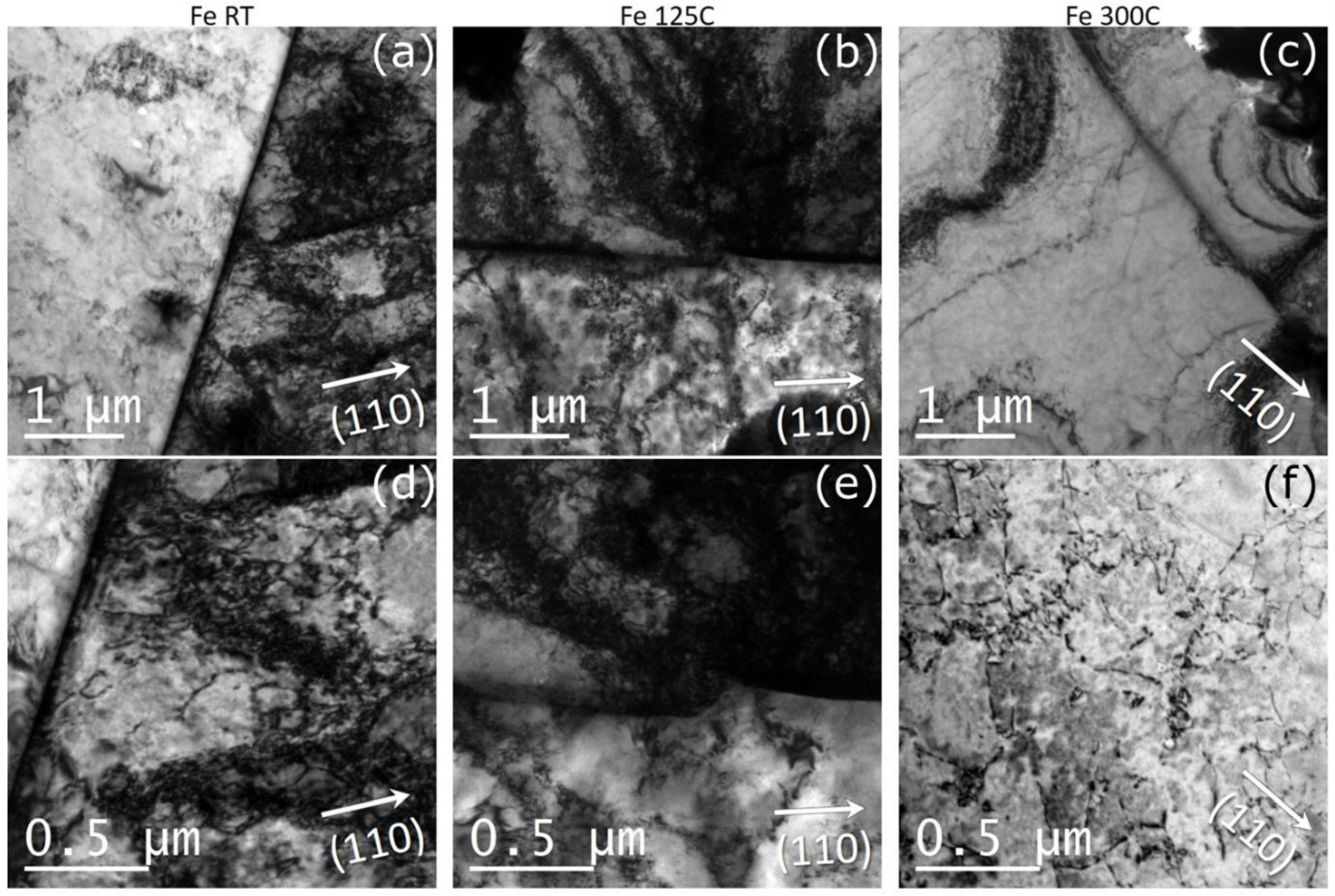

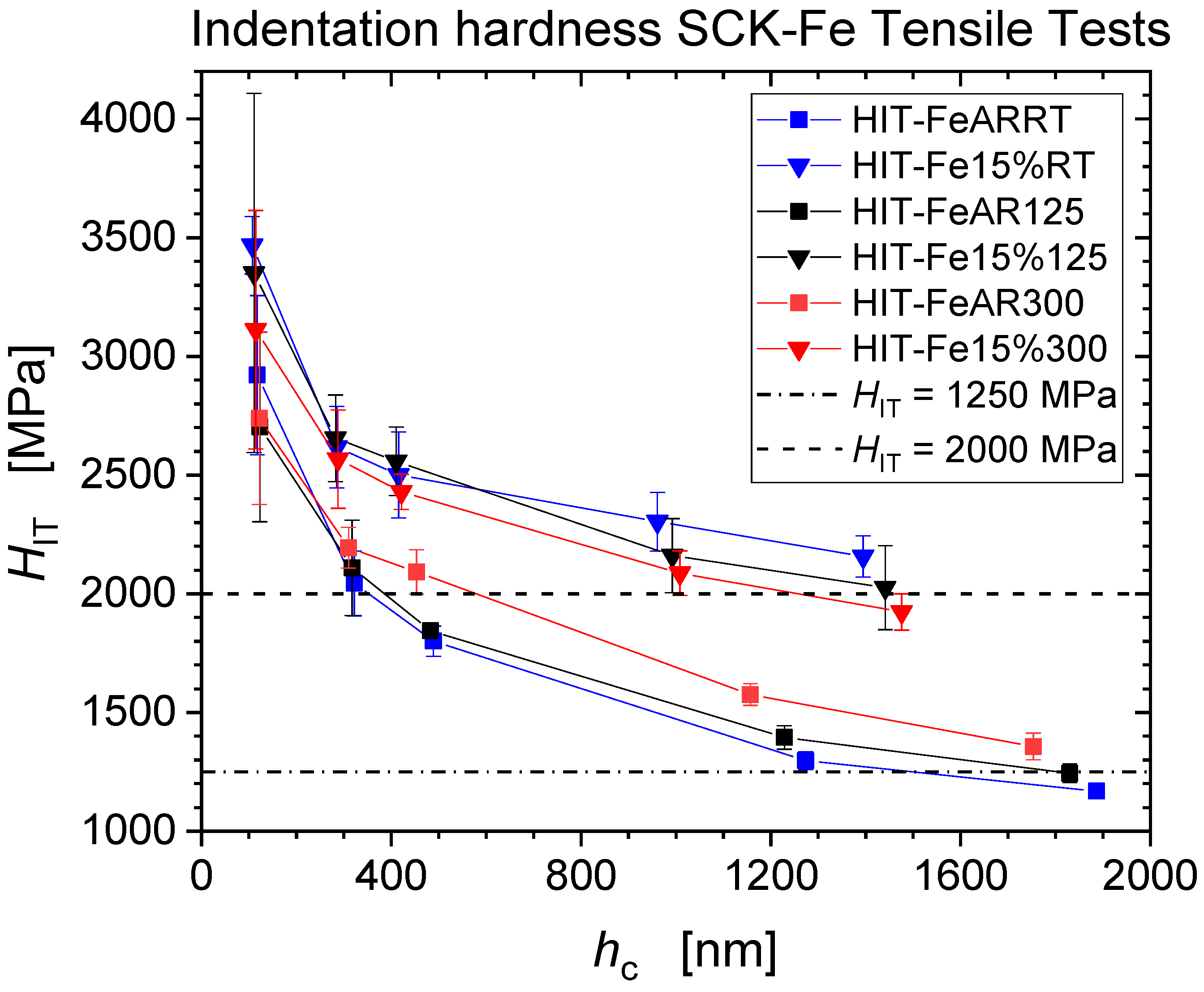
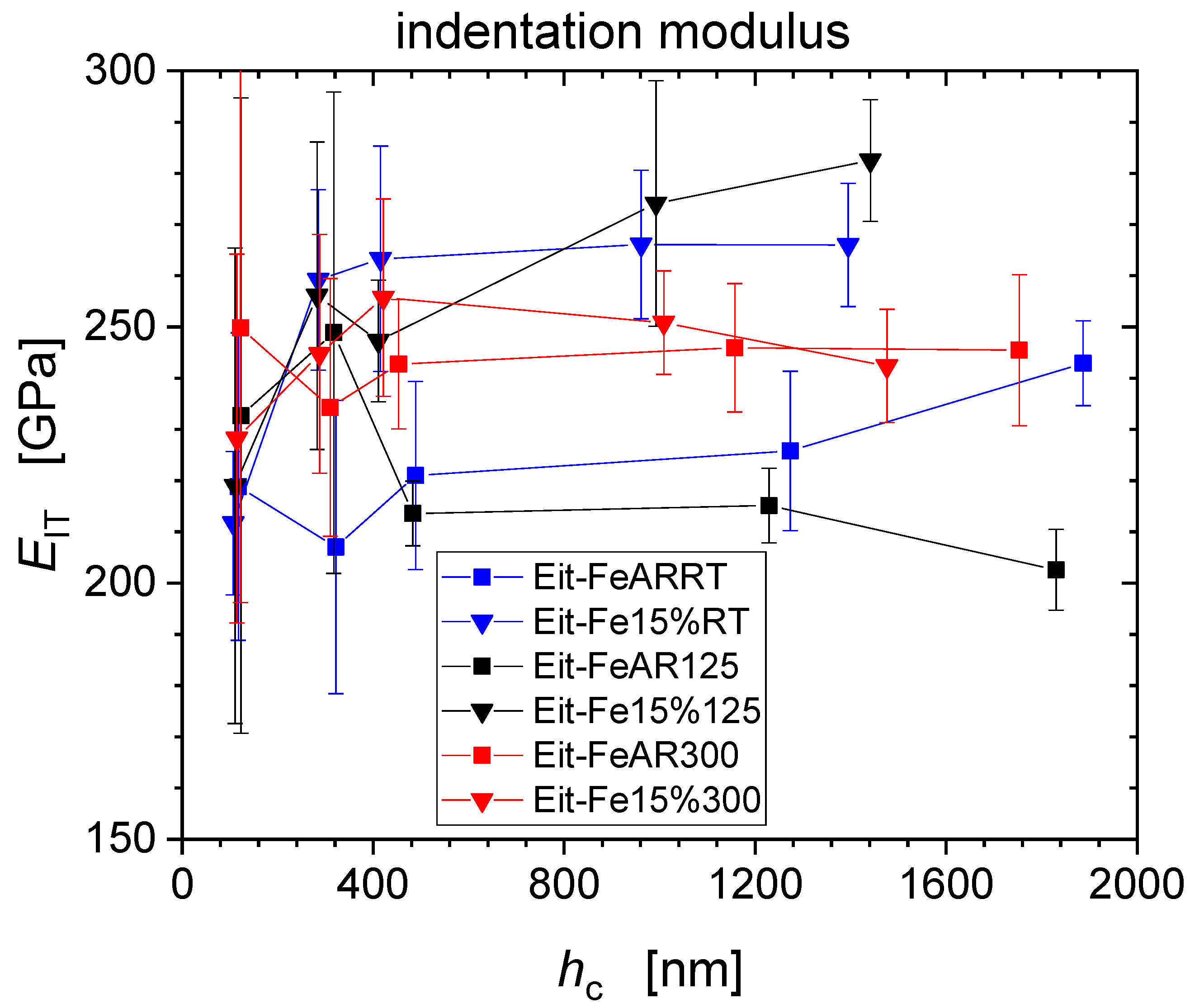
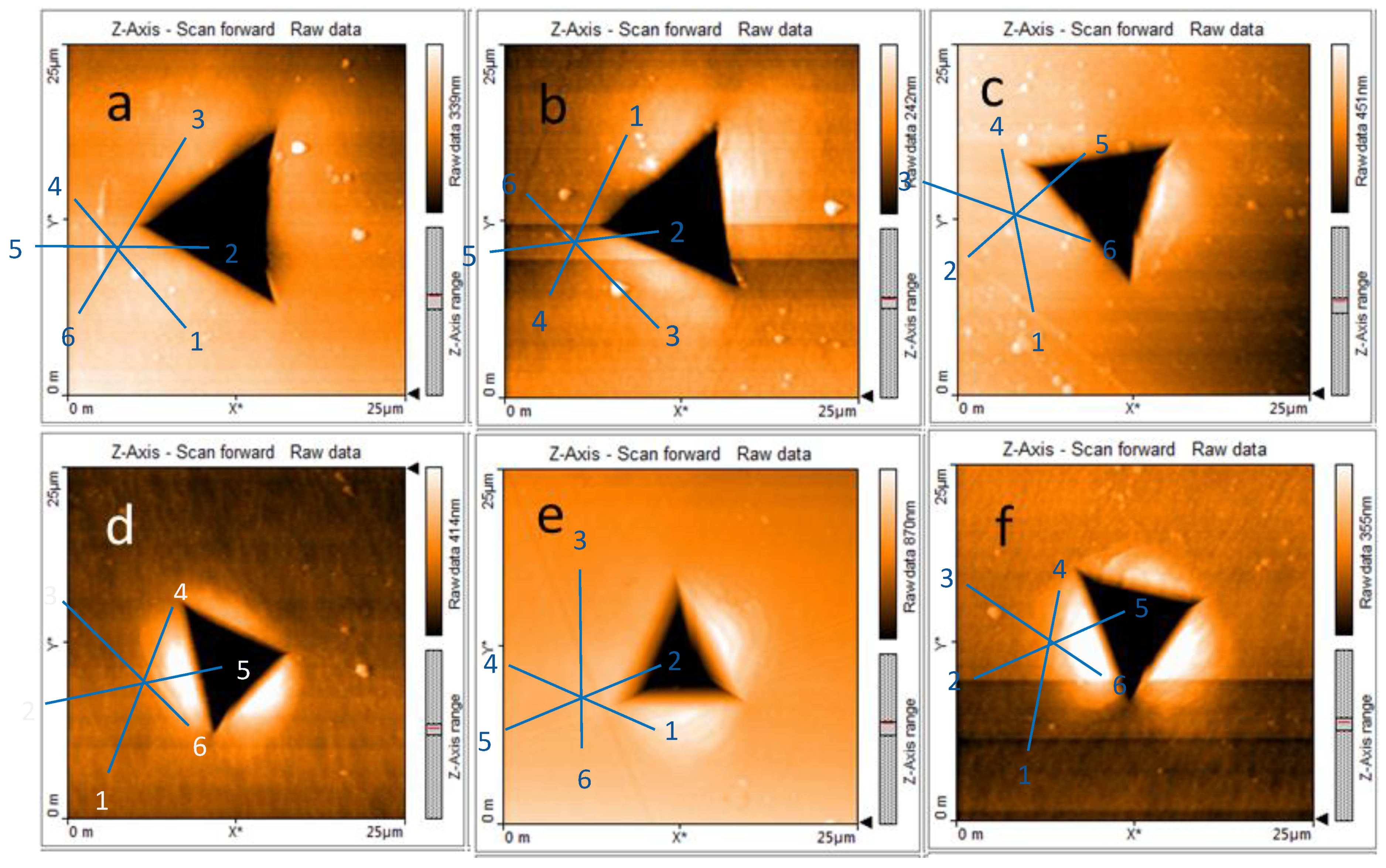

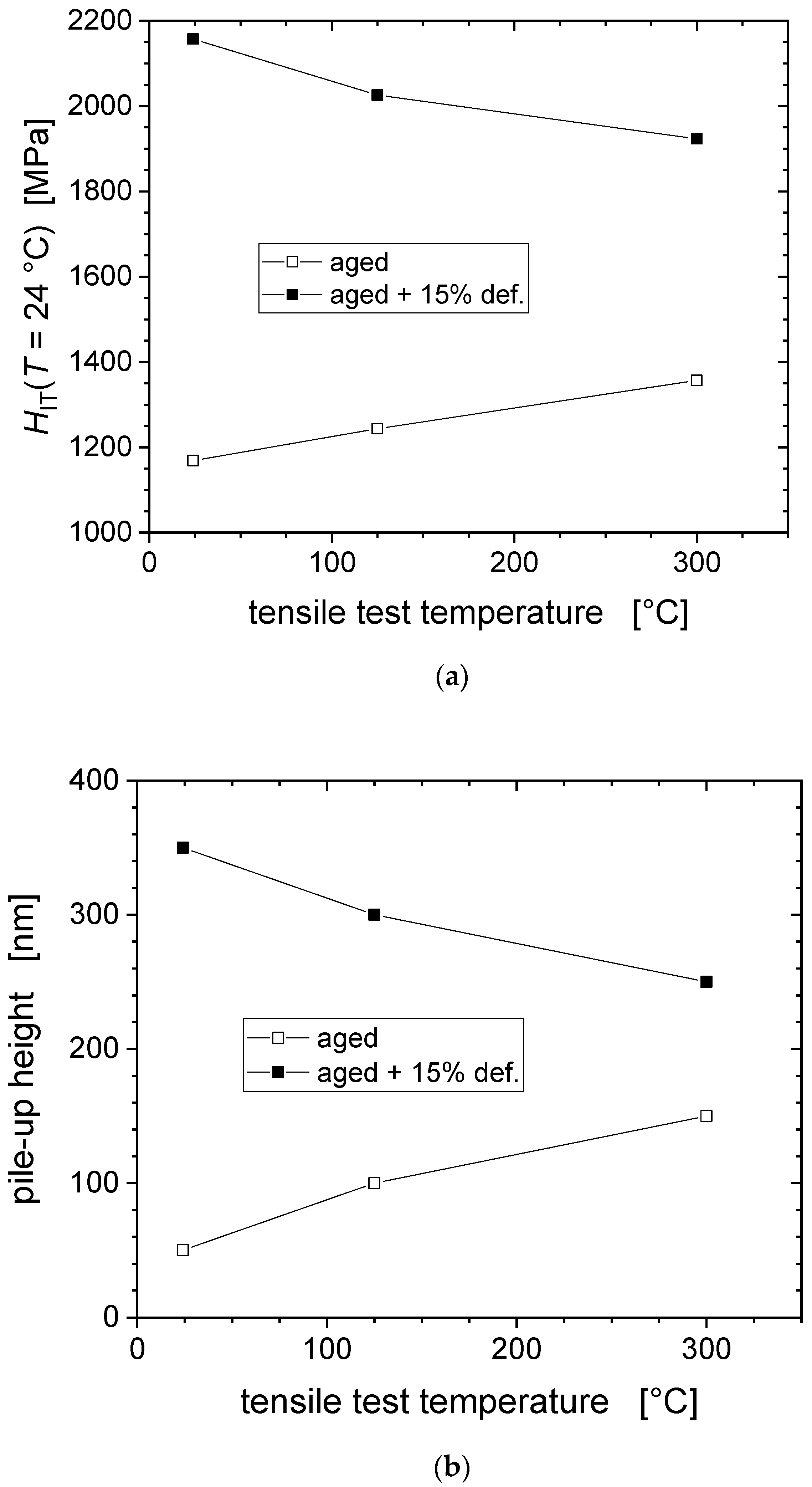
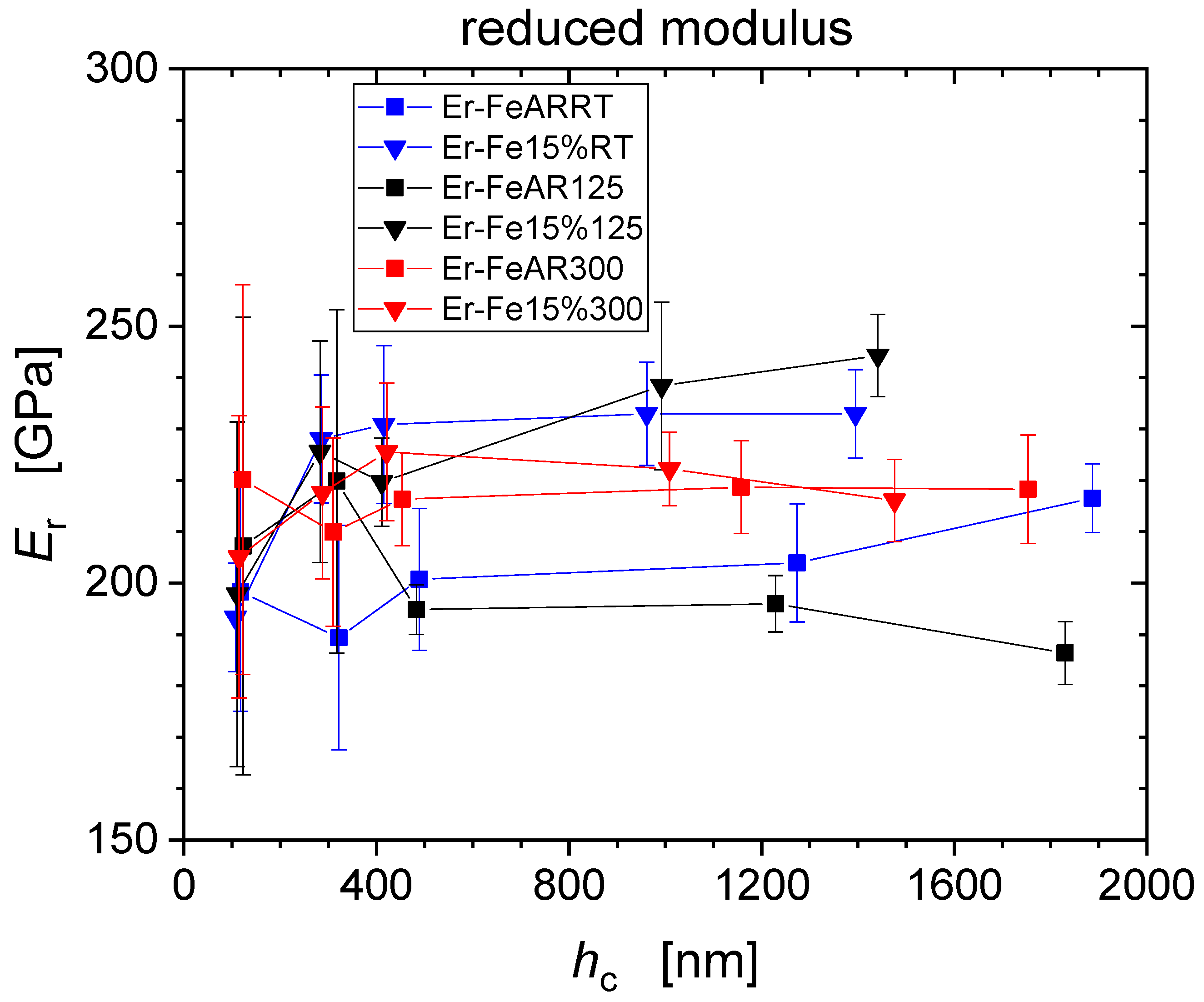
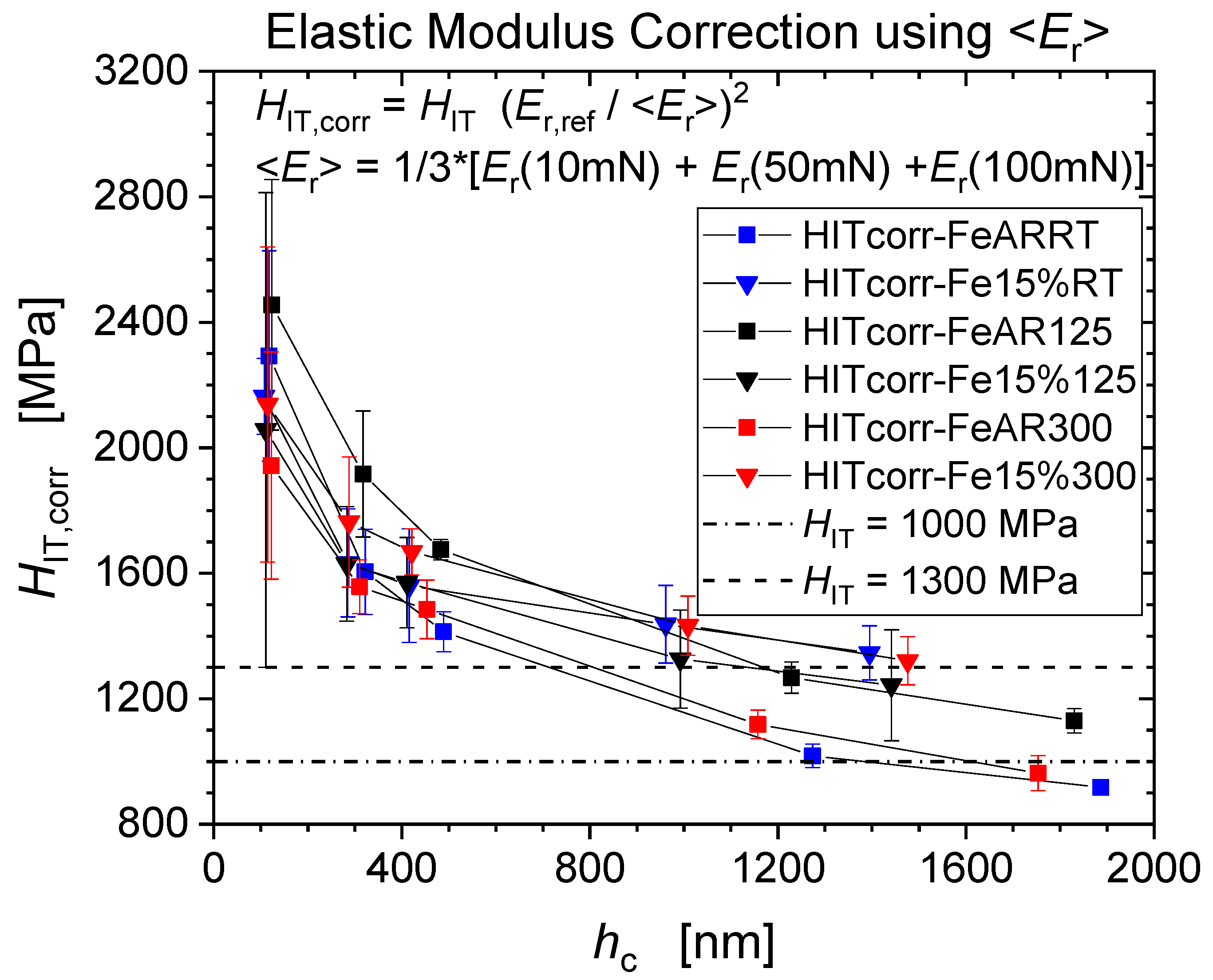
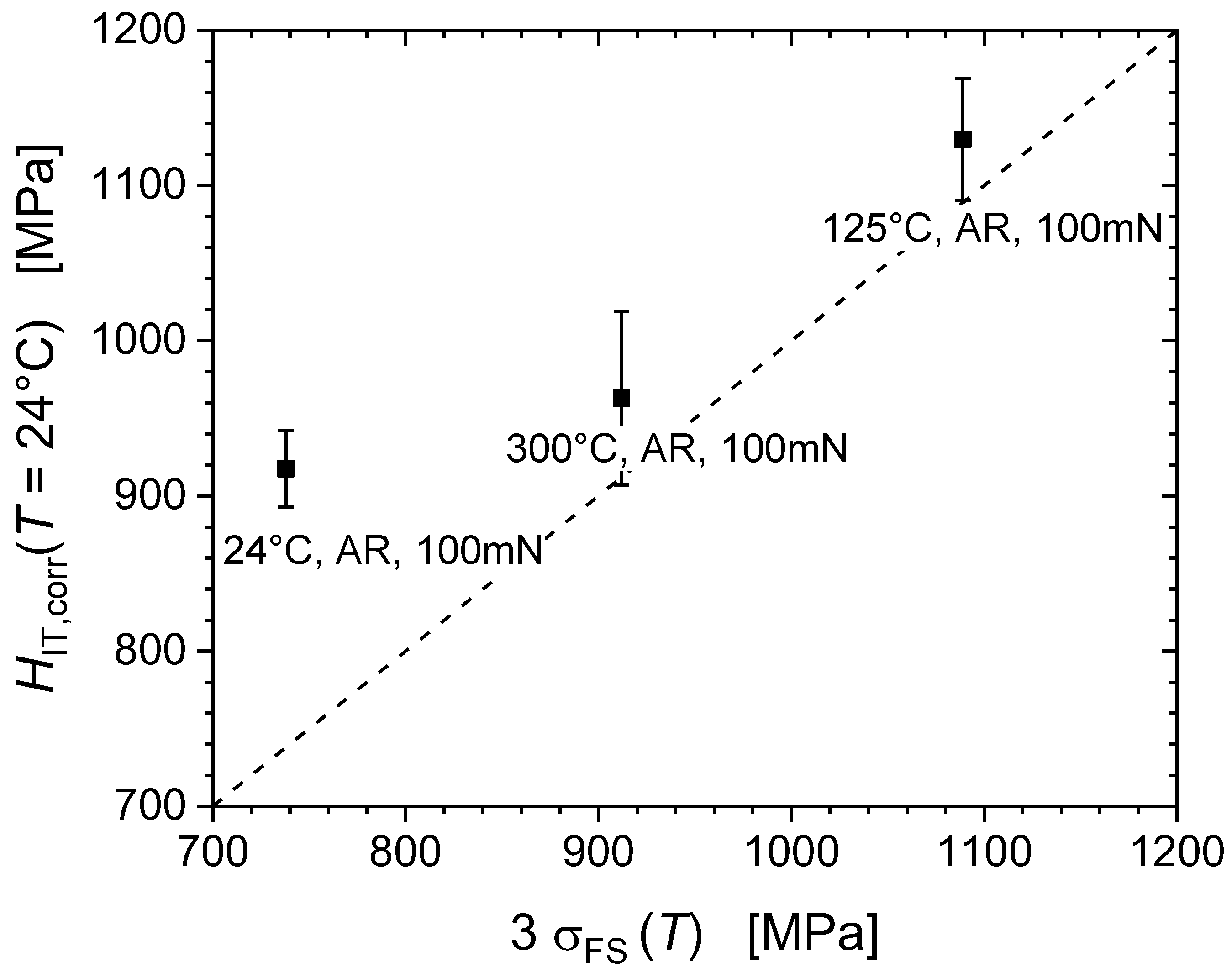
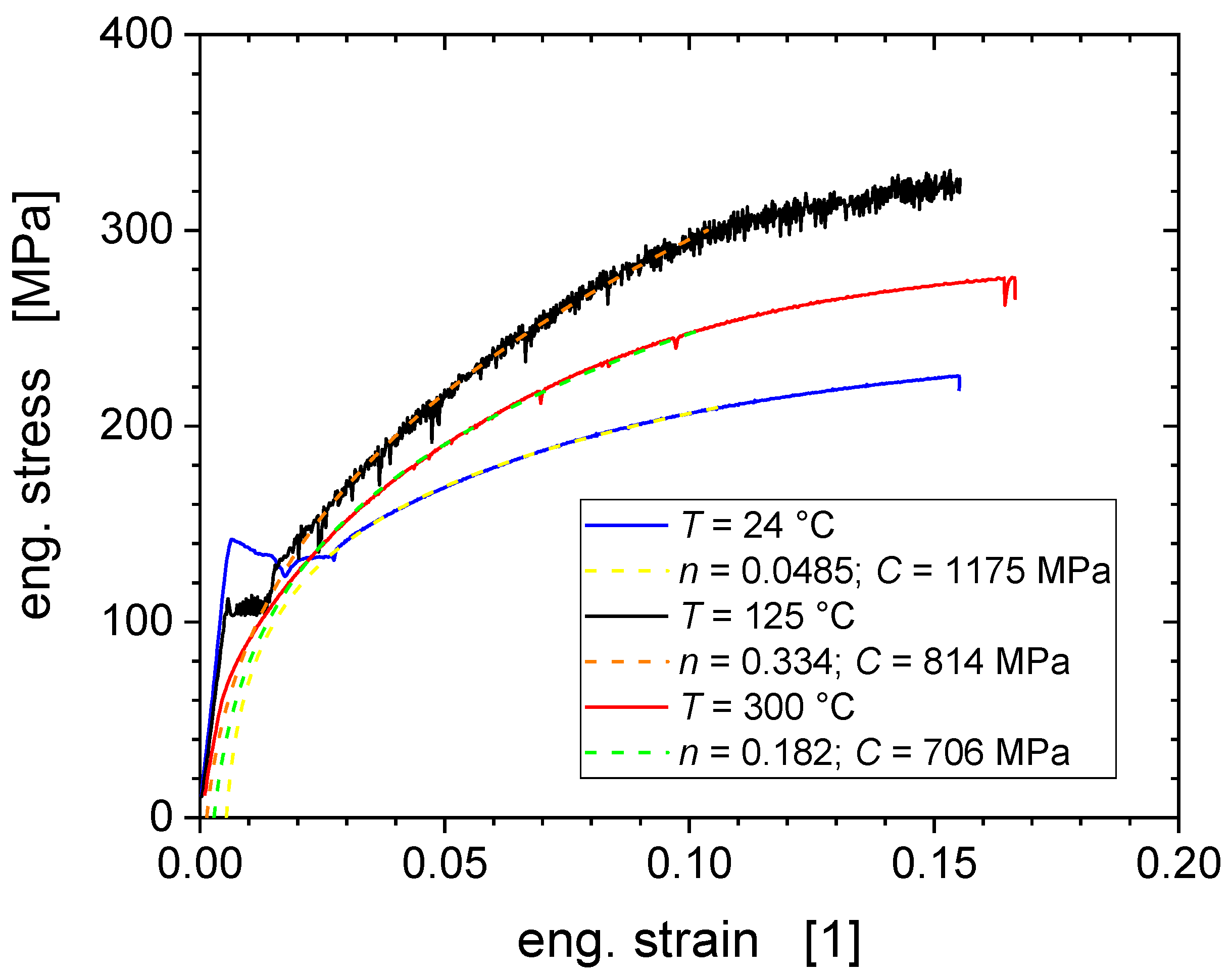
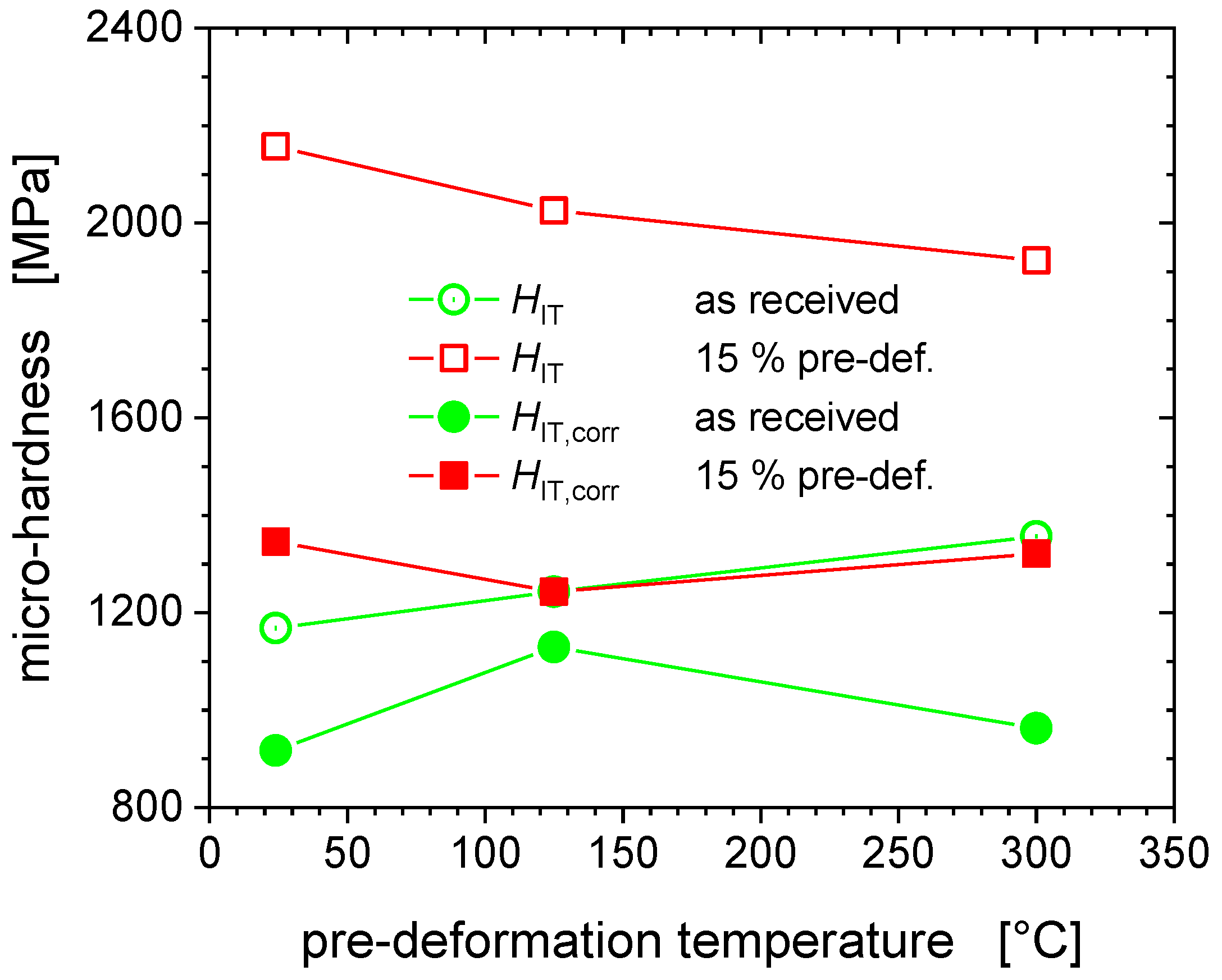
| Cr | Ni | P | Al | Si | V | W | Cu |
|---|---|---|---|---|---|---|---|
| 0.002 | 0.007 | 0.003 | 0.023 | 0.001 | <0.0109 | <0.0099 | <0.0091 |
| Mo | Co | C | Nb | Ti | As | Sn | |
| <0.0082 | <0.0080 | <0.0067 | <0.0036 | <0.0020 | <0.0012 | <0.0010 |
| Specimen Name | Tensile Specimen ID | Temperature | Pre-Deformation |
|---|---|---|---|
| Fe-AR-RT | 1 | RT (24 °C) | Non-deformed |
| Fe-15%-RT | 2 | RT (24 °C) | 15% |
| Fe-AR-125 | 3 | 125 °C | Non-deformed |
| Fe-15%-125 | 4 | 125 °C | 15% |
| Fe-AR-300 | 5 | 300 °C | Non-deformed |
| Fe-15%-300 | 6 | 300 °C | 15% |
| Cloth | Suspension | Force [N] | Rotation [rpm] | Time [min] |
|---|---|---|---|---|
| Sic foil | Water | 80 | 300/150 Co-rotation | 3 |
| MD-Largo | DiaPro All | 120 | 150/150 Co-rotation | 5 |
| MD-Dac | DiaPro Dac 3 | 90 | 150/150 Co-rotation | 5 |
| MD-Nap | DiaPro Nap 1 | 60 | 150/150 Counter-rotation | 3 |
| MD-Chem | OPS | 40 | 150/150 Counter-rotation | 2.5 |
| Deformation Temperature [°C] | Upper Yield Stress [MPa] | Lower Yield Stress σy [MPa] | Ultimate Tensile Strength [MPa] | Final Strength σFS [MPa] | 3 σFS [MPa] | Δσ = (σFS − σy) [MPa] |
|---|---|---|---|---|---|---|
| 24 (RT) | 145 | 125 | 226 | 246 | 738 | 101 |
| 125 | 115 | 103 | 325 | 363 | 1089 | 222 |
| 300 | 82 | 276 | 304 | 912 | 194 | |
| Condition | Reduced Modulus at 10 mN [GPa] | Reduced Modulus at 50 mN [GPa] | Reduced Modulus at 100 mN [GPa] | Average Reduced Modulus [GPa] |
|---|---|---|---|---|
| 24 °C AR | 201 | 204 | 216 | 207 |
| 24 °C 15% | 231 | 233 | 233 | 232 |
| 125 °C AR | 195 | 196 | 186 | 192 |
| 125 °C 15% | 220 | 238 | 244 | 234 |
| 300 °C AR | 216 | 219 | 218 | 218 |
| 300 °C 15% | 226 | 222 | 216 | 221 |
| Deformation Temperature [°C] | ρ [1014 m−2] | [MPa] | σf− Δσ [MPa] | ΔHcorr/3 [MPa] |
|---|---|---|---|---|
| 24 (RT) | 2 | 255 | 134 | 143 |
| 125 | 3.7 | 346 | 86 | 38 |
| 300 | 0.8 | 161 | −61 | 119 |
Publisher’s Note: MDPI stays neutral with regard to jurisdictional claims in published maps and institutional affiliations. |
© 2020 by the authors. Licensee MDPI, Basel, Switzerland. This article is an open access article distributed under the terms and conditions of the Creative Commons Attribution (CC BY) license (http://creativecommons.org/licenses/by/4.0/).
Share and Cite
Veleva, L.; Hähner, P.; Dubinko, A.; Khvan, T.; Terentyev, D.; Ruiz-Moreno, A. Depth-Sensing Hardness Measurements to Probe Hardening Behaviour and Dynamic Strain Ageing Effects of Iron during Tensile Pre-Deformation. Nanomaterials 2021, 11, 71. https://doi.org/10.3390/nano11010071
Veleva L, Hähner P, Dubinko A, Khvan T, Terentyev D, Ruiz-Moreno A. Depth-Sensing Hardness Measurements to Probe Hardening Behaviour and Dynamic Strain Ageing Effects of Iron during Tensile Pre-Deformation. Nanomaterials. 2021; 11(1):71. https://doi.org/10.3390/nano11010071
Chicago/Turabian StyleVeleva, Lyubomira, Peter Hähner, Andrii Dubinko, Tymofii Khvan, Dmitry Terentyev, and Ana Ruiz-Moreno. 2021. "Depth-Sensing Hardness Measurements to Probe Hardening Behaviour and Dynamic Strain Ageing Effects of Iron during Tensile Pre-Deformation" Nanomaterials 11, no. 1: 71. https://doi.org/10.3390/nano11010071
APA StyleVeleva, L., Hähner, P., Dubinko, A., Khvan, T., Terentyev, D., & Ruiz-Moreno, A. (2021). Depth-Sensing Hardness Measurements to Probe Hardening Behaviour and Dynamic Strain Ageing Effects of Iron during Tensile Pre-Deformation. Nanomaterials, 11(1), 71. https://doi.org/10.3390/nano11010071





